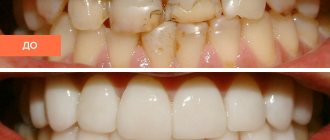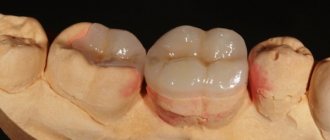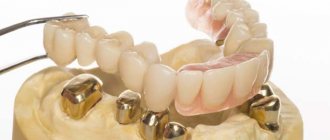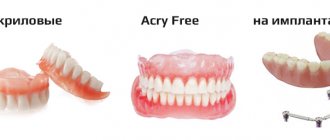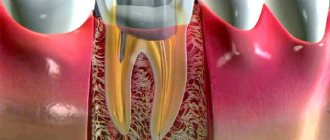The inlay is a one-piece structure, the lower part of which is similar to a stump (therefore a stump). It takes into account the characteristics of the destroyed tooth, so it can be single, double or triple. In complex cases, it may consist of individual elements. The upper part is made of any shape, in accordance with the impression taken. The inlay can be installed without a crown, completely repeating the shape of the tooth. Such microprosthetics are often used in orthopedic dentistry, because even a severely damaged tooth can be completely restored, obtaining an aesthetic dental unit.
Advantages and disadvantages of tabs
- There is no danger of destruction or cracking - the strength and reliability of the inlays is high.
- Resistance to food dyes, color stability.
- The characteristics of the bite are taken into account.
- The shape of the tooth is completely restored and remains unchanged in the future.
- There are no unpleasant sensations at all.
- The result of tooth restoration is highly aesthetic.
- The possibility of the spread of harmful organisms is eliminated.
Negative aspects may arise if you go to clinics with insufficient equipment or inflated prices. In these cases, patients note the lengthy process of manufacturing and installing the inlay and the high cost.
How are restoration inlays installed on teeth?
Installing a restorative inlay on teeth is a multi-step process that always begins with a detailed diagnosis, which will include examination, radiography and computed tomography. After the diagnosis, the type of inlay is selected and a detailed treatment plan is drawn up.
The tooth on which the inlay is planned to be placed is ground down and then an impression is taken from it and sent to a dental laboratory. An inlay will be made based on the impression and the average production time is 5-7 days.
When the inlay is ready, the patient is invited to the clinic for fitting and installation of a microprosthesis. The inlay is fixed in the tooth cavity using special dental cement.
Indications and contraindications for use
It’s worth putting a tab if there is:
- Extensive caries damage (more than 60%) of the tooth tissue;
- Large cavity size;
- Traumatic tooth damage;
- Hyperplasia, dysplasia;
- Wedge-shaped defect;
- The need for protection against tooth wear;
- Installation of bridges simultaneously with root structures.
The use of inlays is not recommended if the patient has:
- Small tooth cavity;
- Carious processes are active;
- There is no quality oral hygiene.
Reconstruction of the functionality of the dentition using an inlay allows you to cope with high loads. This is a great solution, but it can be painful some time after installation. What to do if a tooth hurts under the tab?
The cause of pain may be high sensitivity. If the situation worsens over time, you need to see a dentist and get an x-ray.
If a tooth hurts under the stump tab, then the following reasons are possible.
- Pulpitis is damage to the pulp of a tooth with a preserved nerve. When installing the inlay, the pulp chamber was accidentally damaged. After the anesthesia wears off, the pain becomes severe and intensifies with chewing and contact with cold and warm foods. The patient feels pain under the tab.
- Pressing the inlay into the tooth tissue. A bursting, aching pain occurs, which does not allow establishing a specific location.
- The tab is too large. The patient feels pain only when chewing. The pain is dull, there is no reaction to hot and cold food. The sensations are more like discomfort. In the absence of correction, inflammation of the periodontium or gums develops.
- Infection. Before installing the inlay, the doctor cleans the carious cavity to prevent further spread of the destructive process. If at this moment there is already an infection in the tooth, but has not yet been identified externally, after installing the tab the process will spread deeper, to the pulp and to the roots. If left untreated, the pain under the ceramic inlay will become very severe, the nature of the “sensations” will be pulsating and sharp.
What to do if the tooth under the crown is inflamed and hurts?
Dentures with crowns are an excellent way to restore a damaged tooth. For one reason or another, the integrity of the tooth could have been compromised, and today dentistry offers an affordable and safe opportunity to get a beautiful smile back and completely restore chewing load. This is very important, because a lot in the human body depends on the load on the jaw.
After installing a crown, the patient can forget about it for 10–15 years, and then simply change it after its service life has expired. Problems such as pain or odor from the crown are rare. However, it is worth knowing their reasons. We will look at them further, but for now remember: if a tooth hurts under the crown and it continues for 1-2 days, you need to consult a doctor. There is no need to wait until the pain becomes very severe - discomfort and aching is enough to diagnose and, if there is inflammation, eliminate it.
After examining and studying the pictures, the doctor will draw a conclusion about why the problem arose and tell you how to treat the tooth under the crown. This may include removal and replacement of a prosthesis, treatment of caries with filling.
This type of dental treatment will require one or more procedures. If you have to change the crown itself, you will first need to wait for it to be manufactured.
What complications are possible?
An incorrectly installed inlay can result in the development of a cyst. Treatment will be lengthy and expensive - resection of the root apex will be required.
If you have pain under a microprosthesis or the inlay under the crown hurts, contact dentistry at amazing prices. An endodontist will examine the oral cavity and prescribe additional examination.
- X-ray - to assess the condition of the root and surrounding tissue (the image will show whether there is a cyst;
- EDI – Electroodontodiagnosis to assess the condition of the pulp – the doctor has the opportunity to determine:
- The degree of damage to nerve tissue;
- Is it necessary to open root canals, treat or remove the pulp?
Taking into account the results obtained, effective treatment will be carried out.
About the dental post
A dental pin is a structure made from a special impression. It is installed in a previously prepared root canal of the tooth. The pin is used as a support for dentures.
The pin is installed in the root canal of the tooth
It is worthwhile to dwell in more detail on the classification of rods that strengthen damaged teeth. Since there are a large number of pins and each of them has its own characteristics, it will be extremely important to understand and not get confused in all the diversity.
Remember ! Only the attending dentist decides which pin would be appropriate to use in each possible case.
First of all, there is a classification of pins according to the material from which they are made.
- Metal pins (also called anchor pins) are installed more often than others. Typically made from surgical steel, titanium, as well as platinum, gold and other various alloys.
- Carbon fiber is used as the material for the pins. Such rods are called elastic. Their characteristics are close to the natural dentin layer.
- Fiberglass posts are also very flexible and also have translucent properties - a big plus when placing them on the front teeth.
- Pins made of metal alloys with a polymer coating are called parapulpal. Usually they are installed not at the root of the tooth, but as a supporting structure.
- Another material for rods is gutta-percha. It is good for its environmental friendliness. Pins made from this material are much cheaper than others, but their service life is still shorter.
- Individual stump inlays. They are usually placed when the crown is completely destroyed.
There are several types of pins
There is also a classification based on the method of attachment to the tooth. According to it, the pins can be divided into:
- active pins - secured to threads for strength and durability;
- passive - installed in the tooth canal using a fixing solution. They do not last as long and are used for serious damage and expansion of the tooth canals.
According to the fastening method, pins can be divided into screw, cylindrical and conical.
There are also several types of pins according to the method of fastening
Emergency help
If you can’t see a doctor, and the tooth under the tab hurts, the following measures will help.
- Chewing and temperature stress on the teeth should be completely avoided. Food should be consistent with body temperature and should not require chewing or biting. Broths and pureed soups are the best solution.
- For unbearable pain, take an analgesic or anti-inflammatory drug. The main thing is that the product does not cause allergies. It could be Nimesil, Nise or Analgin.
- If the situation worsens, accompanied by headache and chills, you should contact the nearest medical facility. The staff will call an emergency dentist, and the problem will be solved.
Author:
Mayorov Andrey Mikhailovich
Specialization:
orthopedic dentistry, dental prosthetics, implant installation
The teeth under the crowns hurt when pressed, there is a smell from under the crown
Symptoms that should alert you: teeth under the crowns hurt when pressed, there is a smell from under the crown. The main thing you shouldn’t do is try to self-medicate. Even if you read 10 articles about crown problems, you will not be able to fix the problem yourself. There's nothing wrong with changing your plans for the next week a little and going to the dentist to make sure everything is in order. And if not, then quickly “fix” the tooth.
You shouldn’t try to endure the pain and take painkillers because you have an emergency at work and don’t have time for toothache. This will only worsen the situation and require long-term treatment in the future. Pain always indicates that there is a problem somewhere. This means that dental treatment in Krasnoyarsk will be required in any case and there is no point in postponing it.
Important: the symptom is “counted” even if it occurs only when pressing on the tooth, chewing or exposure to hot/cold temperatures. You shouldn’t turn a blind eye to this - most likely, this indicates a problem. Why does inflammation occur on an apparently healthy tooth under a high-quality crown?
Removing a dental post
The pin is removed in the following situations:
- if the apical part of the root becomes inflamed;
- when a filling needs to be replaced;
- during the preparatory stage before implantation;
- with unprofessional and poor-quality installation of the pin.
Removal of the pin is carried out in several stages. First, old fillings, crowns and other structures installed earlier are removed. Then, using ultrasound, the cement holding the pin is destroyed.
After this, you can directly remove the pin using forceps.
Important! If the pin is very firmly fixed in the root canal of the tooth, then ultrasound treatment is performed - due to vibrations, the pin moves, and this makes it easy to remove it.
After the procedure is completed, the doctor must check the patency of the root canals.
The doctor will definitely check if everything is in order after the procedure.
The pins are removed painlessly; this procedure does not pose any danger to the patient. Even anesthesia is not used in this case - only vibration and light pressure are felt.

